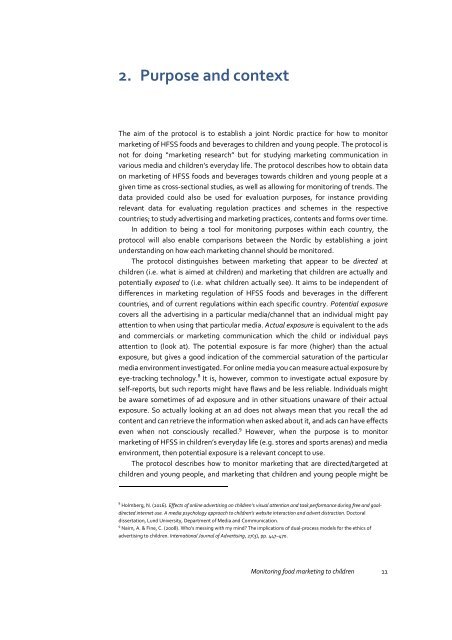TN2018504
You also want an ePaper? Increase the reach of your titles
YUMPU automatically turns print PDFs into web optimized ePapers that Google loves.
2. Purpose and context<br />
The aim of the protocol is to establish a joint Nordic practice for how to monitor<br />
marketing of HFSS foods and beverages to children and young people. The protocol is<br />
not for doing “marketing research” but for studying marketing communication in<br />
various media and children’s everyday life. The protocol describes how to obtain data<br />
on marketing of HFSS foods and beverages towards children and young people at a<br />
given time as cross-sectional studies, as well as allowing for monitoring of trends. The<br />
data provided could also be used for evaluation purposes, for instance providing<br />
relevant data for evaluating regulation practices and schemes in the respective<br />
countries; to study advertising and marketing practices, contents and forms over time.<br />
In addition to being a tool for monitoring purposes within each country, the<br />
protocol will also enable comparisons between the Nordic by establishing a joint<br />
understanding on how each marketing channel should be monitored.<br />
The protocol distinguishes between marketing that appear to be directed at<br />
children (i.e. what is aimed at children) and marketing that children are actually and<br />
potentially exposed to (i.e. what children actually see). It aims to be independent of<br />
differences in marketing regulation of HFSS foods and beverages in the different<br />
countries, and of current regulations within each specific country. Potential exposure<br />
covers all the advertising in a particular media/channel that an individual might pay<br />
attention to when using that particular media. Actual exposure is equivalent to the ads<br />
and commercials or marketing communication which the child or individual pays<br />
attention to (look at). The potential exposure is far more (higher) than the actual<br />
exposure, but gives a good indication of the commercial saturation of the particular<br />
media environment investigated. For online media you can measure actual exposure by<br />
eye-tracking technology. 8 It is, however, common to investigate actual exposure by<br />
self-reports, but such reports might have flaws and be less reliable. Individuals might<br />
be aware sometimes of ad exposure and in other situations unaware of their actual<br />
exposure. So actually looking at an ad does not always mean that you recall the ad<br />
content and can retrieve the information when asked about it, and ads can have effects<br />
even when not consciously recalled. 9 However, when the purpose is to monitor<br />
marketing of HFSS in children’s everyday life (e.g. stores and sports arenas) and media<br />
environment, then potential exposure is a relevant concept to use.<br />
The protocol describes how to monitor marketing that are directed/targeted at<br />
children and young people, and marketing that children and young people might be<br />
8 Holmberg, N. (2016). Effects of online advertising on children’s visual attention and task performance during free and goaldirected<br />
internet use. A media psychology approach to children’s website interaction and advert distraction. Doctoral<br />
dissertation, Lund University, Department of Media and Communication.<br />
9 Nairn, A. & Fine, C. (2008). Who’s messing with my mind? The implications of dual-process models for the ethics of<br />
advertising to children. International Journal of Advertising, 27(3), pp. 447–470.<br />
Monitoring food marketing to children 11


